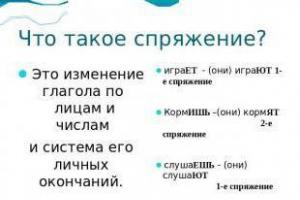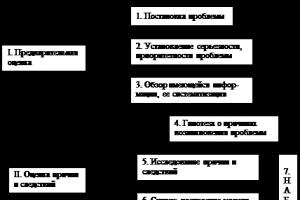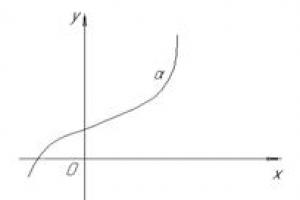The greatest difficulties for students when studying a morphology course are caused by 1st and 2nd conjugations. They are very often confused with each other, and a rather large list of exceptions is forgotten. How to quickly and efficiently study this topic? Let's try to figure it out further.
Verb as part of speech
Before you start studying the ending, you need to understand some subtleties.
What makes our speech “move”, bring inanimate objects to life, be dynamic? Of course,
Our language is simply impossible to imagine without it. It would be difficult for us if this part of speech suddenly disappeared. Even when describing a static object, we still use it. In fiction, verbs are used as an effective means of artistic imagery and expressiveness.
For example, personification, which animates objects, can never do without a verb. Let's compare: The clock hand moves in a circle. The clock is ticking. When does our imagination begin to play? Undoubtedly, in the second. The language becomes more “alive” and bright. Of course, the clock has no legs, but, nevertheless, it is on the similarity of movement that the personification is built. Examples include: the river rushes, the wind howls, the storm rages.
It is thanks to verbs that such a figurative, expressive feeling is created.
Conjugation is...
When starting to study the endings of verbs 1 and 2 conjugations, we need to find out what this term means.
Almost every part of speech can change in its own way. Nouns, for example, are divided into cases and numbers. Adjectives, in addition to this, also change according to gender. What about the verb? It can be changed by persons as well as numbers. This is what is called conjugation. Each of them has its own set. They are often confused with each other. And we will find out how to remember these nuances well and no longer make written and oral mistakes.

It is worth recalling another important rule, which includes verb conjugation. 1, 2, 3 - there is only declination! And the verb has only two conjugations. Let's talk about them in more detail.
1 conjugation
The largest number of questions in the parts of speech course are related to the endings of verb conjugations. They should be identified by the infinitive. The first category usually includes those that in the initial form end in -ot (flog), -at (break), -et (sick), -yat (walk) and others .
But, as in any rule, there are exception verbs 1 2 conjugations.
So, the first also includes two more words ending in - it: shave and lay. This is explained by historical changes in these forms.
How will we determine the conjugation? It’s very simple: put the word in its initial form. It answers the question “what should I do?”
For example: The students are doing their homework. Verb do bring to the initial form - do. Let's see where it ends. In this case, it's -at. Accordingly, we will classify such a word as the first conjugation.
2 conjugation
The endings of verbs 1 and 2 conjugations are very similar to each other. But if you know how to correctly distinguish them, there will be no difficulties.
The second conjugation usually includes those that end in -it: speak, build, come. As mentioned above, this list does not include the words shave, and lay.
In this case there are many more exceptions than in the first conjugation. We will include as many as eleven more exception words to the second.
These are seven verbs -to: offend (kitten), twirl (ball), depend (on circumstances), see (beauty), hate (impudence), watch (film), endure (bullying). We will also include here four words for -at: drive (in the neck), hold (in hands), breathe (quickly), hear (song).

When determining the endings of verbs 1 and 2 conjugations, you need to know the list of exceptions in advance.
Finding out which of them the word refers to is not difficult.
Example: The baby is very dependent on the mother.
Verb depends put it in the initial form - depend. It would seem that everything is simple, it ends with -there are, and therefore there should be 1 reference. But, remembering the exceptions, we will change our point of view: he, after all, is on this list and belongs to 2 references.
One more example: Workers are building a new house.
In the initial form of the verb build ends with -it. He is no exception, and therefore we will boldly classify him as the second conjugation. Therefore, be careful when starting the task.
The table will help you remember 1 and 2 verb conjugations better.

With its help, information becomes more structured and better remembered.
Change by person
Now we know, Personal endings of verbs are the next stage that needs to be studied.
As we have already noted, this part of speech has the ability to change according to persons.

Let us remind you: in order to determine whether a verb belongs to the 1st, 2nd or 3rd person, it is necessary to substitute the appropriate pronouns for it.
In the first person the word I (singular) or we (plural): I ask, we write.
For the second you need to substitute you (singular) or you (plural): you say, look.
To the third - he (it or she) or they (plural): shines, they think.
Those endings that result from this are called personal.
Conjugating verbs using stressed endings
Not in all cases will we doubt how to correctly write the word given to us. If the stress in a verb falls on the ending, we will use it correctly without hesitation.
For example: They say they are flying, you will come.
In this situation, the endings are in a strong position, which does not cause any difficulties.
Be careful if the word is in the infinitive. Sometimes emphasis can only be misleading. For example, the verb “to live”. It ends with -it, which is shock. But at the same time, in the plural form the word has the ending -ut(live). This means that it must be classified as the first conjugation. Therefore, make sure that the emphasis falls on the ending only when the word is only in the personal form.
Complex cases
What to do when the ending is unstressed? For such a case, there is a special set of personal endings, by which we learn about the conjugation.
The first conjugation always has the letter “e” in the singular: You try, you disappear, you eat, you chat. In the plural there are always endings either -ut, or -yut: they fight, they show themselves.
They are difficult to define in an unstressed position, but in this case the infinitive will come to the rescue.
The 2 conjugations are different: in the singular we write the letter “and”: depends, drives. In plurals it is necessary to use endings -at or -yat: They build, they keep.
Remember that in the unstressed position the ending is more vulnerable and causes difficulties in writing. For this reason, it is necessary to put the word in the initial form and use it to determine whether it is 1st or 2nd reference. it relates.
Conclusion
We managed to cope with the difficult task and point out the subtleties of determining the endings of verbs. Take your time when a word is challenging you. Remember that the infinitive 1st sentence has an ending -ot, -et, -yat etc., and in the second only -it. Add to this rule a rather long list of exceptions. In order to remember all these words, there are many poems consisting only of them.

Just learn personal endings, it's not difficult at all. Then you will not have problems spelling them. In case of difficulties, you can always refer to our article to refresh your knowledge on this issue.
Verb conjugation is a constant grammatical feature of this part of speech. The article describes ways to determine the conjugation of verbs, provides tables with visual examples of various conjugation options, and also indicates exceptions to the general rules.
What is verb conjugation
Verb conjugation in Russian is a system for changing the forms of present tense verbs by numbers and persons. Verb conjugation refers to the constant grammatical features of a given part of speech. There are two main types of conjugations in the Russian language - 1st and 2nd conjugation of verbs. According to the rules, verb conjugation is determined in two ways:
- According to the stressed personal endings of present tense verbs;
- If the ending of the verb is unstressed, the conjugation is determined by the infinitive suffix (indefinite form).
How to determine verb conjugation using personal endings
To determine the conjugation of a verb with a stressed personal ending, it is enough to conjugate the word by numbers and persons. The list of personal endings of verbs 1 and 2 conjugations with examples is presented in a clear table of verb conjugations in the Russian language.
| Face | Verbs 1 conjugation | Verbs 2 conjugations | ||||
| Unit number | Mn. number | Examples of verbs 1 conjugation | Unit number | Mn. number | Examples of verbs 2 conjugations | |
| 1st | -у(-у) | -eat | I draw, I sew, I grow draw, sew, grow |
-у(-у) | -them | I will cook, buy, keep cook, buy, keep |
| 2nd | -eat | -yeah | draw, sew, grow draw, sew, grow |
-hey | -ite | cook, buy, keep prepare, buy, keep |
| 3rd | -et | -ut(s) | draws, sews, grows draw, sew, grow |
-it | -at(-yat) | cooks, buys, holds cook, buy, keep |
How to determine the conjugation of verbs with unstressed endings
To find out the conjugation of verbs with unstressed personal endings, it is necessary to form the infinitive form of the verb (infinitive) and determine the conjugation of the verb using the infinitive suffix.
What is conjugation? The answer is simple - it is a change in verb forms according to non-constant characteristics, which are person (1-3) and number (singular or plural). The face suggests who is performing the action. There are three categories of face.
Example: you draw, you need to choose a suitable pronoun for it, here it fits - You. From this it is clear that you draw costs in units h., has the characteristics of a second person. We can conclude that the conjugation of verbs in the Russian language is their change according to non-constant characteristics.
Features of verb conjugation in Russian. Tables.
Inflections that appear during conjugation are called personal.
Attention! The table presented above is important to remember very well.
Some subtleties
So that every test in morphology does not cause panic attacks, and you can feel confident when passing the Unified State Exam, you need to thoroughly understand the basic principles and rules of Russian spelling.
For example: Laughter is heard. We write I (2 questions). The beds will water. Verb of the first conjugation. gives the letter Y. The process of changing verbs affects spelling, it is this that decides what suffix the participle will have.
Kinds
If the inflection is under stress, then there can be no doubt about the correctness of the spelling. What are the endings of verbs of both conjugations in Russian you will learn from the table:
If a morpheme other than inflection is stressed, then the infinitive, or more precisely, the letter combination located at the end of the word, will help in correlating the lexeme and the group.
Verbs of the second conjugation, according to established language rules, end in -it, except for the verbs shave, lay, build. They supplement the exclusion group from 1 reference. (look, see, offend, depend, breathe, hate, hear, drive, hold, twist, endure).
All verbs that do not fall into the second group belong to the first, including shave, lay, build.
Verbs 2 conjugations include examples like this: ready it, hurry it.
Important! Clearly understand the exceptions for the 1st and 2nd conjugations.
An example of using the basic rule in practice
- The people are fighting... N.f. fight. We discard the postfix. The letter combination –ot is an indicator of 1 reference. The table gives us the letter E in the blank. Bor people e tsya.
- She's ready..t. N.f. Prepare. This is a second conjugation verb. Non-permanent signs: 3 years, singular. number. Using the table, we determine that the letter I should be in place of the gap. It is ready And T.
- Shave your beard. We put it in . Shave - we determine what conjugation it is. We assign it to group 1. Bre e t beard.
- We look...m. We put it in n. f. To see - we determine what conjugation it is. 2nd group. We are the species And m.

Verb conjugation
Some nuances
The verbs to disdain, to run and to want occupy a special place among their fellows. Linguists have determined that when these lexemes change, the following is observed: they acquire inflections, both 1 and 2 conjugations. For this reason they are called heteroconjugated.
Linguists classify the verbs “to eat” and “to give” into a separate group because when modified they show personal endings that are not traditional. Their uniqueness determines their classification into a separate group.
Video tutorial. Verb conjugation in Russian
Verb conjugation part 1. What you need to know to determine the conjugation.
Conclusion
It is important to master this material so that further acquaintance with participles and gerunds does not cause difficulties. Spend a little time and thoroughly learn a rule that will help you avoid making spelling errors in your writing while completing exam tasks.
- perhaps one of the most difficult topics in the Russian language course.
However, it is imperative to master it well: not a single school dictation can do without verbs.
In addition, tasks related to determining the conjugation of a verb will certainly be found in the test part of the final exams in the Russian language - in the ninth grade and in the eleventh.
Despite the fact that determining the conjugation of a verb and correctly writing its endings is taught in the elementary grades, there are plenty of mistakes regarding this rule in the works of schoolchildren of all age categories.
It is not easy to conquer His Majesty the Verb... But we will still try to do it, step by step. First, let's figure out what this notorious thing is. verb conjugations.
What is verb conjugation?
Conjugation is the change of a verb in persons and numbers.
What does this look like in practice?
The person and number of a verb can be determined by substituting one of the appropriate personal pronouns for it.
Let's remember these pronouns:

So, to the verb you're coming you can substitute :( You're going- this means it is a 2nd person singular verb. And to the verb let's sing a pronoun is substituted We is a 1st person plural verb. (They) glue- 3rd person plural, (I am telling- 1st person singular, etc.
Now let's learn how to conjugate verbs (that is, change them according to persons and numbers).
For example, this is how verbs are conjugated do And glue:

First, second and third person verb endings are called personal. The forms of verbs formed during conjugation also have the same name.
By the way, we highlighted the endings of verbs not by chance. There are a huge number of different verbs in the Russian language. But almost all of them, according to their personal endings, are divided into only two types.
The first type of verbs (i.e. first conjugation verbs) has personal endings:
-y ( or -yu), -eat, -eat, -eat, -et, -ut ( or -yut) .
The endings of verbs of the second type (i.e. verbs of the second conjugation):
—y( or -yu), -im, -ish, -ite, -it, -at ( or -yat) .
Surely you have already noted that we have conjugated verbs of both types: verb do refers to first conjugation, and the verb glue - co second conjugation.
Personal endings of verbs of the first and second conjugation need to be remembered!

Why determine verb conjugation?
Really, why? Why do teachers periodically complicate the lives of schoolchildren, forcing them to cram - in poetry and prose - exception verbs, to repeat again and again the seemingly memorized rule for determining the conjugation? It turns out there is a reason - and an important reason.
Try, without knowing the rules, to insert the missing letters into verbs:
(we) s...m,
(we) view…m.
Not an easy task, is it? Even if nature has endowed you with innate literacy, writing the personal endings of verbs correctly is not easy.
It is much easier for those who have determined that the verb sow belongs to the first conjugation, and the verb see- to the second.
From the list of personal endings of verbs of the first conjugation, we select the ending that suits the meaning of the verb s...m - -EM. And we write the verb correctly:

From another list - personal endings of the second conjugation - we select the desired personal ending for the verb view...m - -IM. Let's write the verb correctly:

By the way, the vowels in the suffixes of present participles also depend on the conjugation of the verb. If the participle is formed from the first conjugation verb, its suffixes will be:
-ush-, -yush-, -om-, -eat- .

U participles formed from verbs of the second conjugation, the suffixes are as follows:
-ash-, -box-, -im- .

So, the ability to determine verb conjugations is necessary in order to correctly write personal endings of verbs and participle suffixes. Now another quite reasonable question arises - how exactly to determine the conjugation of a verb?
How to determine the conjugation of a verb?
To determine the conjugation of a verb, first of all, we put it in the indefinite form.
Let us remind you: in indefinite form(it is otherwise called an infinitive) the verb answers the question what to do? or what to do? —look, search, carry, protect, hope, etc.)
Let's look at what the verb ends with. For example, the verb look ends with -there are, search- on -at, carry- on -ty, take care - on -who, hope- on -yat(postfix -xia discard) etc.
But, in fact, the very rule .
The second conjugation includes:
—all verbs ending in the infinitive in -IT, except three - shave, lay, rest ;
— 11 exception verbs, which end in -There IS And -AT(you need to remember them!) -
7 verbs starting with -ITE:

4 verbs ending in -AT:

The first conjugation includes
all other verbs, including exception verbsshave, lay, rest.
Note. This method of determining conjugation is only suitable for verbs in which the personal ending is not stressed.
Do not try to determine the conjugation of verbs with stressed personal endings by the indefinite form.
Firstly, this is not necessary, since vowels under stress are heard clearly, which means that the rule is not required to write them correctly at the endings of verbs.
Secondly, when determining the conjugation of verbs with stressed personal endings by the infinitive, you risk getting confused: verb fly, for example, ends in an indefinite form in -ET (and if you apply the rule to it, it turns out that it is of the first conjugation). However, personal forms of the verb fly have all endings of the second conjugation ( years them, years look, years ite, years it, years yat). Consequently, this verb must be classified as the second conjugation.
The conjugation of verbs with stressed personal endings is determined by the endings themselves, and not by the indefinite form!
How to apply the rule?
So, we found out that determining the conjugation of a verb is necessary in order to correctly write vowels in personal endings. In practice it looks like this.
Suppose you need to insert missing letters in verbs:
(We)s...m,
(They)counting,
(You)drank...sh,
(He)hold...t.
The personal endings of these verbs are unstressed, and to determine the conjugations, you need to put the verbs in the indefinite form.
Se...m - to sow . In the infinitive, the verb ends in -yat, which means it refers to first conjugation. Let's remember personal endings of verbs 1 conjugation:

We choose from the list the ending that suits our meaning: - EM. We write the verb correctly: I'm eating .
Pricking - pricking. In the infinitive form the verb ends in -ot and therefore also applies to first conjugation(on postfix in this case we do not pay attention: it does not affect the spelling of the verb). Select the appropriate ending from the list:

Without spaces, the verb looks like this: count yut xia .
Saw...sh - saw . The infinitive of this verb ends in -it — that means we have a verb second conjugation. Let's remember personal endings for verbs of the second conjugation and choose from them what suits the meaning:

Without spaces, the verb is written like this: drank look.
Hold... t - hold.The verb ends in -at in the infinitive. Let us remember: the verb to hold is one of the four exception verbs in -аt related to to the second conjugation (prefix u- does not affect the spelling of the verb). We select from the list the ending that suits the meaning:

We write the verb according to the rule: hold it.
Variably conjugated verbs.
There are verbs in the Russian language that, when conjugated, acquire personal endings of both the first and second conjugation. There are only three such verbs: want, run and dream. Since these verbs cannot be classified as either the first or the second conjugation, they are considered differently conjugated.
Let's analyze the forms of the verb want. In the singular it has the endings of the first conjugation: want eat, want no. But the plural forms are conjugated according to the second type of conjugation: hot them, although ite, although yat .
All personal verb endings run drums: beige them, beige look, beige ite, beige it, run ut . As you can see, in the third person plural the verb has the ending of the first conjugation -ut. The rest of its forms are conjugated according to the second conjugation.
Verb breeze it not used in the first and second person. As for the third person, in the singular the verb acquires the ending of the second conjugation (brezh it) , and in the plural – the ending of the first conjugation (brezh ut) .
Verbs of special conjugation.
Verbs in the Russian language, when conjugated, usually acquire personal endings of one of two types of conjugation. The exception is special conjugation verbs that have specific personal endings. These are verbs There is And give- the most ancient words, apparently, one of the first to appear in all languages of the world. Let's analyze their forms.
Verb There is (meaning “to eat”) in the plural is conjugated like verbs of the second conjugation: units them, units ite, units yat . But the singular endings in the forms of this verb are special: e m (ending -m), e sew (ending -sh), e st (ending -st).
Verb give in the plural it is also conjugated as verbs of the second conjugation ( dad them, dud ite ), and as a first conjugation verb ( dad ut ). As for the singular, the endings here are specific, just like the verb There is: Yes m (ending -m ), Yes sew (ending -sh), Yes st (ending -st).








